|
|
|
|
|
Minskin photos courtesy of Paul McSorley, www.minskin.com |
||
SPARSE-COATED & PARTIALLY-COATED CATS
The origins of the major hairless breeds are well documented elsewhere so I have included a summary only. In some instances there appear to be several versions of events, dates of origin or disagreement over some issues. Where this is the case, I have included all relevant information without prejudice. Other opinions are mine alone.
FUR-POINTED CATS
Once the gene for hairlessness has appeared, it is possible to introduce it into other breeding programs. Whether this is desirable is a matter of debate. For example, the Hemingway Sphynx is a polydactyl hairless cat suggested in 2001 by a Don Sphynx breeder (it was previously nicknamed the Polyfynx). Around the same time, another breeder was using Canadian Sphynx and breeding them to Munchkins and domestics to produce the Minskin. The Minskin is neither a short-legged Sphynx nor a hairless Munchkin, but has its own unique look and is described as "fur-pointed". The Minskin is neither a short-legged Sphynx nor a hairless Munchkin, but has its own unique look. For more information on the Minskin see Short-Legged Cats.
|
|
|
|
|
Minskin photos courtesy of Paul McSorley, www.minskin.com |
||
SPARSE-COATED CATS
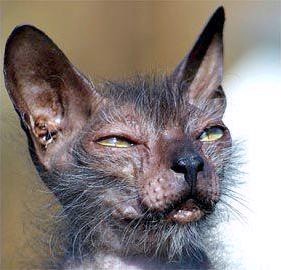
There is a mutation known as "sparse fur" which eliminates all but the guard hairs, which tend to be short. The classical "sparse fur" mutation described in veterinary literature is associated short guard hairs, skin problems and unsightly brown exudate, but is by no means the only the only "sparse fur" mutation in existence. During the 2000s, a number of sparse-haired cats have appeared. In addition to the sparse coat, some display an unusual "grizzled" colour. Some of these have now been selectively bred as the Lykoi breed. Genetic variability means a few become hairless rather than having the breed's characteristic grizzled sparse coat.
In 2003, a magazine featured an almost hairless cat. Described as the result of inbreeding, it was bald apart from long whiskery guard hairs all over the body. It was described by one correspondent as strange and rather ugly, but in a way that puts it back at lovely! A brother and sister born to a domestic shorthair also turned up with a very similar mutation, but were homed from a cat shelter as pets. The male of the pair, "Pyewacket", is owned by Tricia Janes and became famous in the LiveJournal community after she posted his photos.
Pyewacket and his sister were born to a grey and white domestic shorthair of unknown ancestry. Both kittens were completely hairless when born, but later grew the sparse coats shown in the photos. Of the two, Pyewacket's coat is the sparsest and facially and in conformation the two cats differ. The majority of his hair is on his spine and tail and resembles a "balding mohawk (mohican)" haircut. He has hardly any fur on his head and very, very little on his legs. He has little hair on his face and none on his belly, ears or chest. When adopted, his age was estimated at 12 weeks, but a veterinarian revised that estimate to 4 - 5 months, but undersized compared to a regular cat of that age. He apparently likes to sleep under the bedcovers. Tricia describes him as resembling the original Mexican Hairless (which was believed to be 25% smaller than regular shorthairs and also had a sparse coat during the winter), rather than the sparse hair mutation, but he showed progressive hairloss, eventually becoming completely hairless. A biopsy showed there was no disease process, meaning this is a random genetic mutation. Despite the skin issues that accompanied his hair loss, he is a happy and comfortable cat.
|
|
|
|
|
|
|
Pyewacket photos courtesy of Tricia Janes; note his smaller than usual size. By 2017, Tricia described him as "Completely sticky now. First year or two he had bits of hair on and off - the mohawk, the mullet etc. In the last few years we have been battling skin issues but he is the sweetest and most loving cat. He was a stray and he had sister that was already adopted who was furry with no undercoat." | ||||
The Lykoi is a sparse-haired mutation from a domestic shorthair. This mutation has occurred previously, for example “Pyewacket” described above, and the “Powderpuff Sphynx”, but had not been developed as a breed. The Lykoi foundation cats came from unrelated litters. The first litter, a brother and sister, was born 2010 to a black domestic shorthair. DNA tests showed that they lacked the Devon Rex/Sphynx mutation. A little later that year, some partially haired Sphynx outcrosses were advertised, but turned out to have the same sparse-hair mutation. . A Sphynx outcross is either naked, or haired (it cannot be both), so we knew that these were not Sphynx outcrosses. Further DNA tests showed the cats had no skin abnormalities or disease, but some hair follicles were unable to produce hair, while the product hair follicles were unable to maintain normal hair growth. During moulting, the coat may also have patchy bald areas.
The name Lykoi refers to their “werewolf-like” appearance. The first Lykoi-to-Lykoi breeding was in 2011, resulting in a single female kitten with the same hair pattern as the parents. The cats are medium sized, foreign in type, affectionate and those from good breeders who raise their cats in the family home are curious to the point of fearlessness (unfortunately those from bulk breeders are fearful and poorly socialised). TICA recognised the breed for registration in 2012 and only allows outcrossing to non-pedigree black shorthairs.
Lykois are hairless around the eyes, nose, muzzle and on the ears. The extremities are sparse-haired – the hairlessness is distributed in a similar way to the temperature-dependent colourpoint pattern with more fur growth on warmer areas. Genetically, Lykois are shorthairs with restricted fur growth. They lack an undercoat. Although soft to the touch, the fur is coarse-looking. They also have a unique (in pedigree breeds) roan colour; a 50/50 mix of coloured hair to white hair giving a salt-and pepper appearance. The genetically black Lykoi has fur resembling the grizzled fur of a wolf. Because roan is not (currently) a recognised colour with cat registries, the cats had to be registered as solid coloured with amelanistic hair evenly dispersed throughout the coat.
Lykoi sparse hair is not the same gene as Sphynx of Devon Rex (which are both variations of the same gene). In the case of the Lykoi, some hair follicles lack all the necessary components required to create hair, hence the lack of undercoat. Those follicles that are able to produce hair, lack the proper balance of these components to maintain the hair, which is why Lykoi can become temporarily bald during moulting season. A few purebred Lykoi have remained completely bald after 6 months which may be indicative of unwanted genes.
While the Lykoi breed must have the grizzled grey colour, the sparse hair mutation is independent of colour as this ginger cat demonstrates.

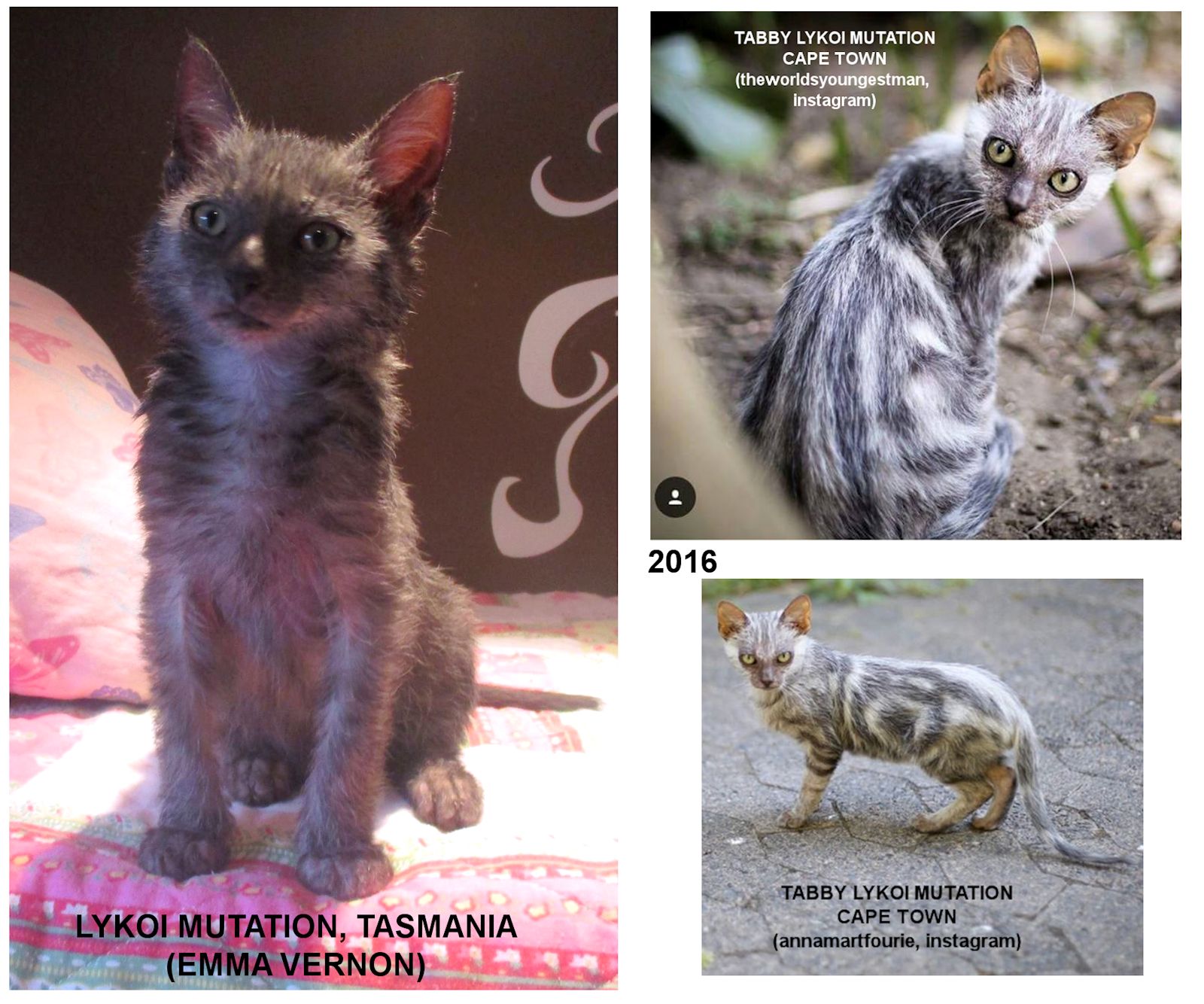
In 2016, Barbara Gandolfi discussed the genetics of the Lykoi cat. She looked at histological analyses of hair and hair follicle features in skin biopsy samples from seven Lykois and seven domestic shorthair cats. Gandolfi and her colleagues did not find any alterations in the hair structure in the Lykoi cats, but they did find that the cats tended to have significantly fewer hair follicles as well as fewer hairs sprouting from each follicle. The team genotyped 20 Lykoi cats and a dozen domestic shorthair control cats using the Illumina Infinium 63K Feline array. They obtained information at more than 40,000 SNPs (Single Nucleotide Polymorphisms) and found that Lykois clustered near both Persian cats and Scottish wildcats. They also narrowed in on a chromosome B1 region which appeared linked to the breed. A shared haplotype block, spanning more than a million bases of the cat genome, appeared to be conserved within all of the Lykoi cats they tested.
- Reuben M. Buckley, Barbara Gandolfi, Erica K. Creighton, Connor A. Pyne, Michelle L. LeRoy, David A. Senter, Delia M. Bouhan, Johnny R. Gobble, Marie Abitbol, Leslie A. Lyons, 99 Lives Consortium, Werewolf, there wolf: variants in Hairless associated with hypotrichia and roaning in the lykoi cat breed, Genes 2020, 11(6), 682; https://doi.org/10.3390/genes11060682
The Lykoi phenotype is a form of hypotrichia (sparse hair) where there are fewer hair follicles than normal, some degree of white blood cell build-up around the follicles (inflamed follicles - folliculitis), and the hair follicles are miniaturized or otherwise abnormal. The mutations are recessive and do not appear to cause additional health concerns apart from sparse hair and folliculitis. Some variants cause more periodic hair loss, possibly associated with the varying levels of sex hormone levels. Lykoi breeders can now use genetic testing to monitor the variants in the population and choose whether or not to breed from a particular cat. There are now tests for Lykoi alleles hrCa and hrVA.
These are the mutations found in the Lykoi breed and the allele names given (based on where the mutant allele was first identified):
Tennessee & Missouri lineages
hrTN allele – mutation: Exon 3 c.1255_1256 dupGT
Some lines have been bred together so that cats are heterozygous eg hrTN/hrVA. The cats from France had been cross bred with cats from Italy and the USA. The Tennessee, Virginia and Texas lines had been bred together. Other lines only had a single mutation type. This means that multiple different mutations can produce the Lykoi phenotype.

Other Lykoi-like cats have been introduced into the breeding programme from Texas, Missouri, Canada, California, South Carolina and Vermont, often from feral colonies. They are only bred in black, although the dilute colour, blue, also occurs, resulting in a grey-roan colour. Some have the white spotting gene hence pet-quality bicolour Lykoi. In randombred populations they can occur in any colour or pattern.
Lauren (kopperkyttin) sent me this photos in 2015. The Lykoi breeder, who was one of the three to found the breed, considers Landon (red bicolour) and Frankie (colourpointed) Lykoi type cats apart from the colour. They are different from the standard roan Lykoi as far as their shed cycles go. Landon came from a litter of kittens in Massachusetts. The owner wanted to find them homes as she was afraid a shelter would put them down because of their unusual coats. He had a similar sister and two normal coated tortie sisters. Frankie came from a woman who had barn cats which kept producing these Lykoi-type kittens. Her dog kept killing the kittens so she contacted the Lykoi breeders who took the the cats from her. Lauren was lucky enough to get Frankie.

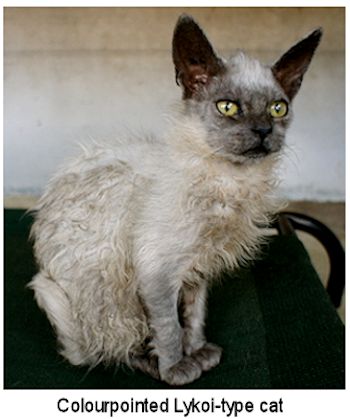
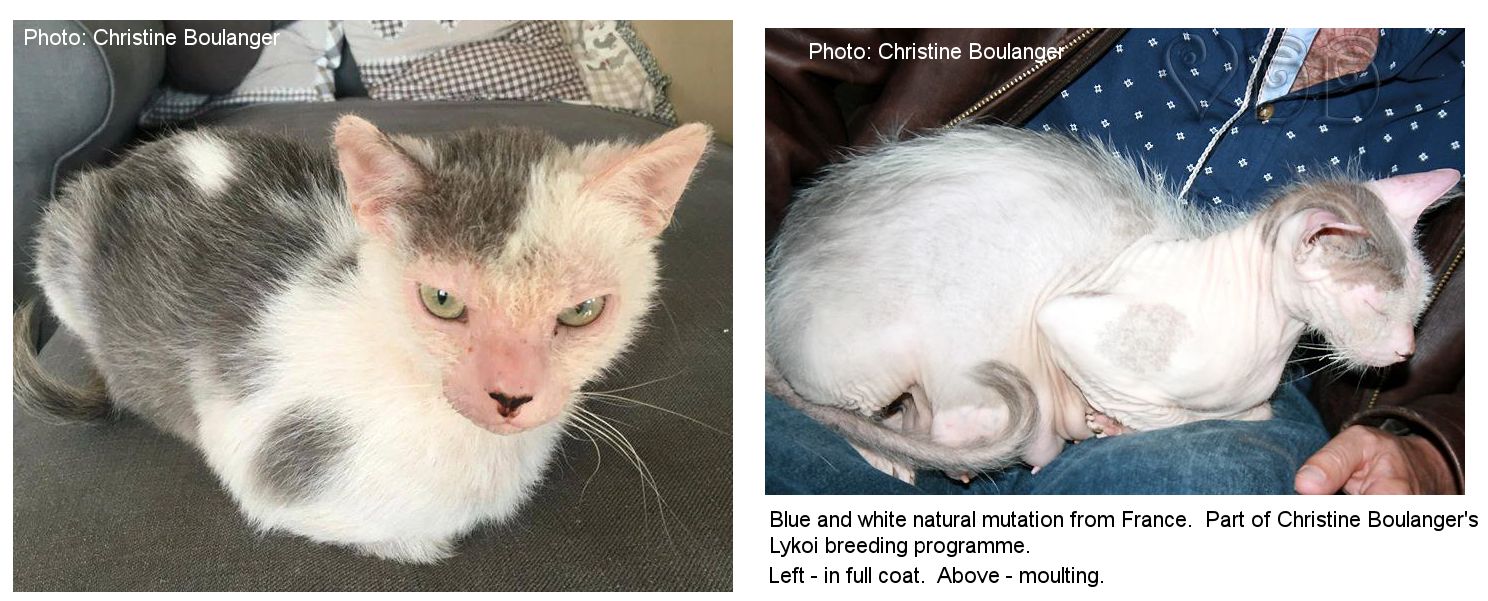
Possum (below) was born in central North Carolina in July 2015 in an otherwise normal looking litter of strays. She was the runt and was the only kitten with the sparse-hair trait. Possum was born hairless except for a few patches of grey fur. Her rescuers quickly found homes for the other kittens, but they feared that strange-looking Possum would not easily find a home. Luckily Possum was adopted by a friend of the rescuers.
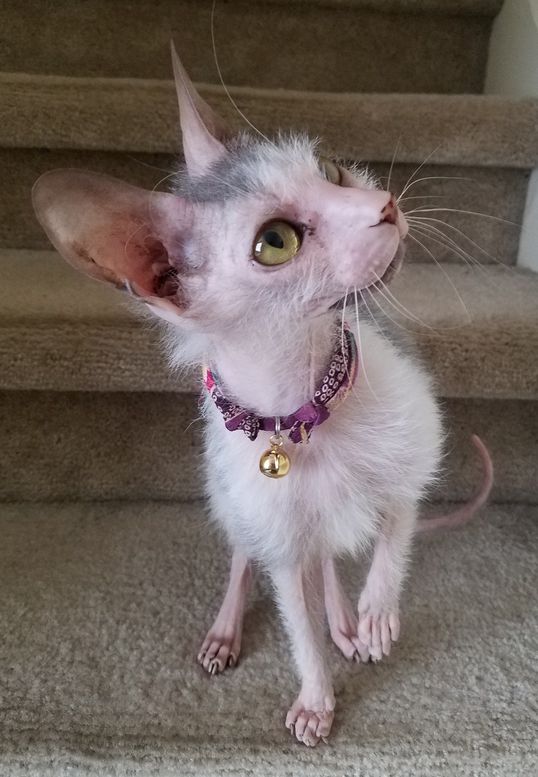
Christine Boulanger's Falyn is a brown blotched tabby roan natural mutation from South Carolina. She was probably born around May or June 2017 and was anaemic and weighed 100 grams when found so her age is just a guess. She will be incorporated into the Lyko programme if her mutation is found to be compatible with existing Lykoi cats.
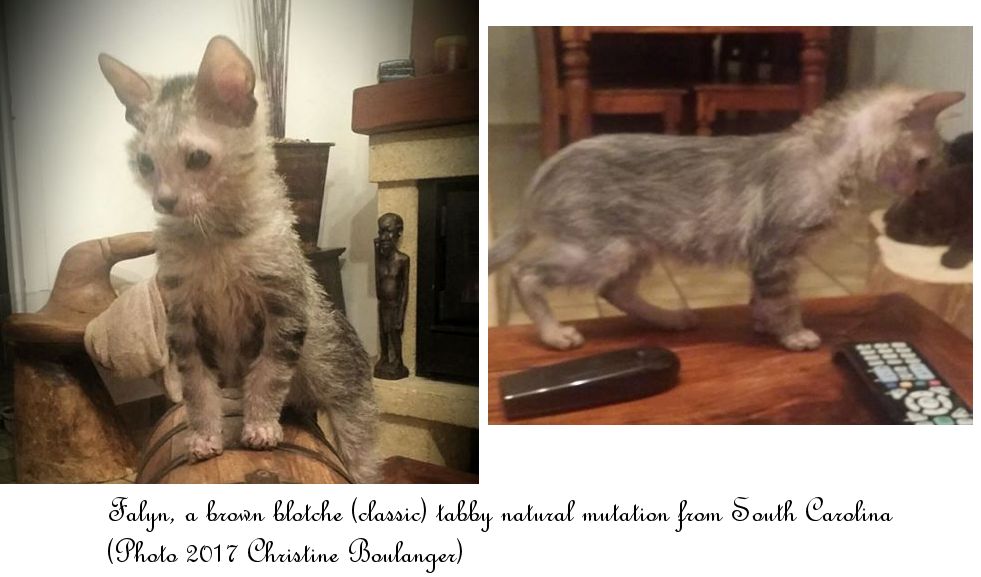
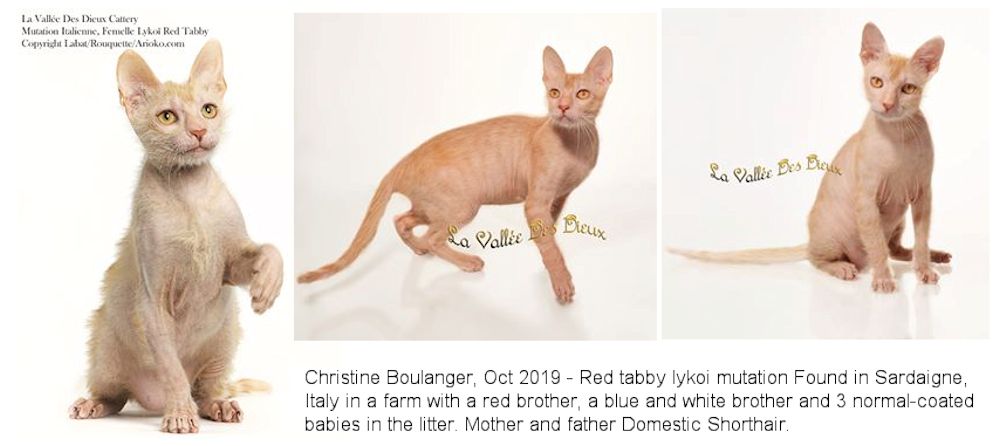
RUFF-AND-TROUSERS CAT
In April 2018, “pownalisaa” from Germany sent me these photos of her partly hairless cat, Karl who is hairless on his back and has fur on his chest and underside. His parents are Maine Coon and Don Sphynx. The Don Sphynx hairless gene is dominant and is variable in expression. The Canadian Sphynx gene is recessive and would not be expressed when crossed with a Maine Coon. The most recent photos show Karl aged 6 years old. During his first year he had fluffy fur. He had an amazing personality, being intelligent and somewhat doglike. He also likes to sleep in the washbasin. The photos show Karl with a full coat, during hair-loss and as he is as an adult. This hair-loss stage is one expression of the Don Sphynx gene.
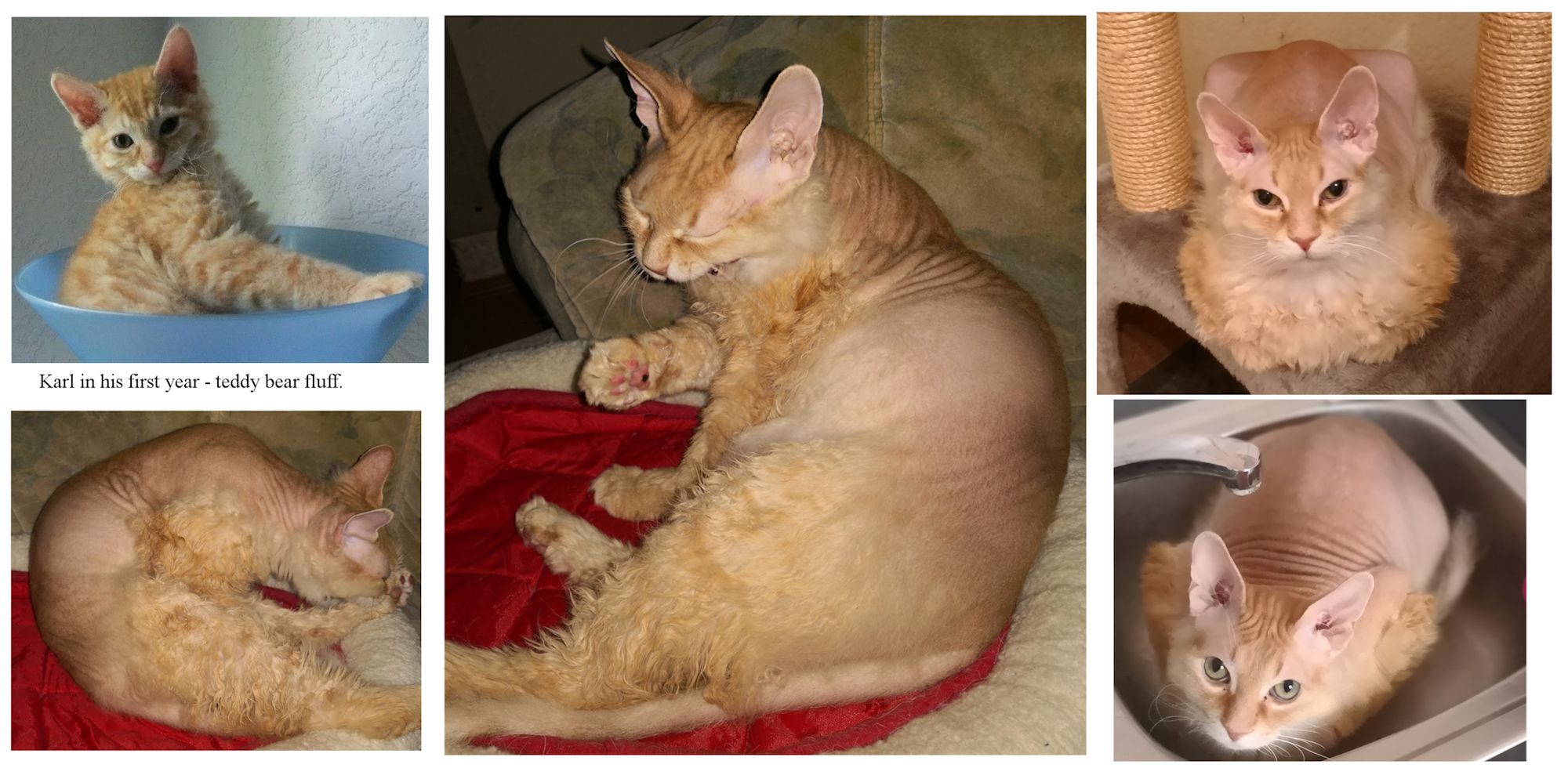
Karl resembles the "powderpuff Sphynx" (below). Unlike Ugly Bat Boy (below) Karl does not have a lion-like mane and is best described as having a ruff and trousers. Is is possible that someone read about Ugly Bat Boy and bred a Don Sphynx and Maine Coon together, not realising that the hairless stage comes after the moult, if at all?
MANED CATS
Back in the 1990s, the "Longhair Sphynx" or "Powderpuff Sphynx" was a cat fancy April Fool's joke, poking fun at breed classification by registries. Several years after the joke, a longhaired mutant Sphynx really did appear. It is a neutered domestic pet and is pictured here (above left). It had long, fine fur on the chest and sides and short fur on the legs, but was bald elsewhere. This gave it the appearance of a maned cat.
|
|
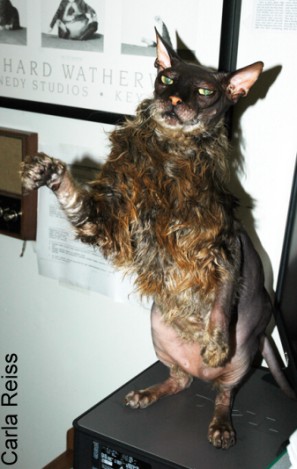 |
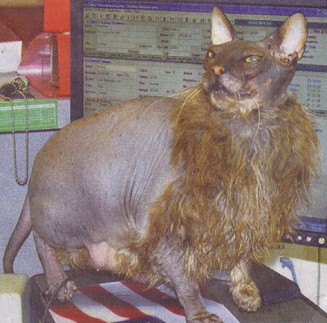 |
In February 2009, a similar cat was reported in Exeter New Hampshire, USA. Known as Ugly Bat Boy (above right), he was part of a litter of four kittens, 2 normal plus Ugly Bat Boy and a similar-looking female sibling that died at a few weeks old. Bat Boy caught they eye of vet Stephen Bassett (who had treated Bat Boy's sister) and now lives at the vet clinic. Some rumours claimed him to be a Sphynx/Maine Coon mix. According to Carla Reiss, who provided the photos, the vet who owns Ugly Bat Boy believes the mutation was a result of a local random mating. Uggs had a sister who only lived three weeks, but the vet has spayed/neutered one or two others. It is likely that inbreeding is causing a mutant gene to show up.
Uggs died aged 12 on the night of Saturday 31st August 2013 from heart complications. During his lifetime, Uggs had become a fixture at the Exeter Veterinary Hospital and many people visited just to take a picture of him or to buy a "Have you been Ugged today" tshirt. He was known not only for his looks, but also for his sweet personality.
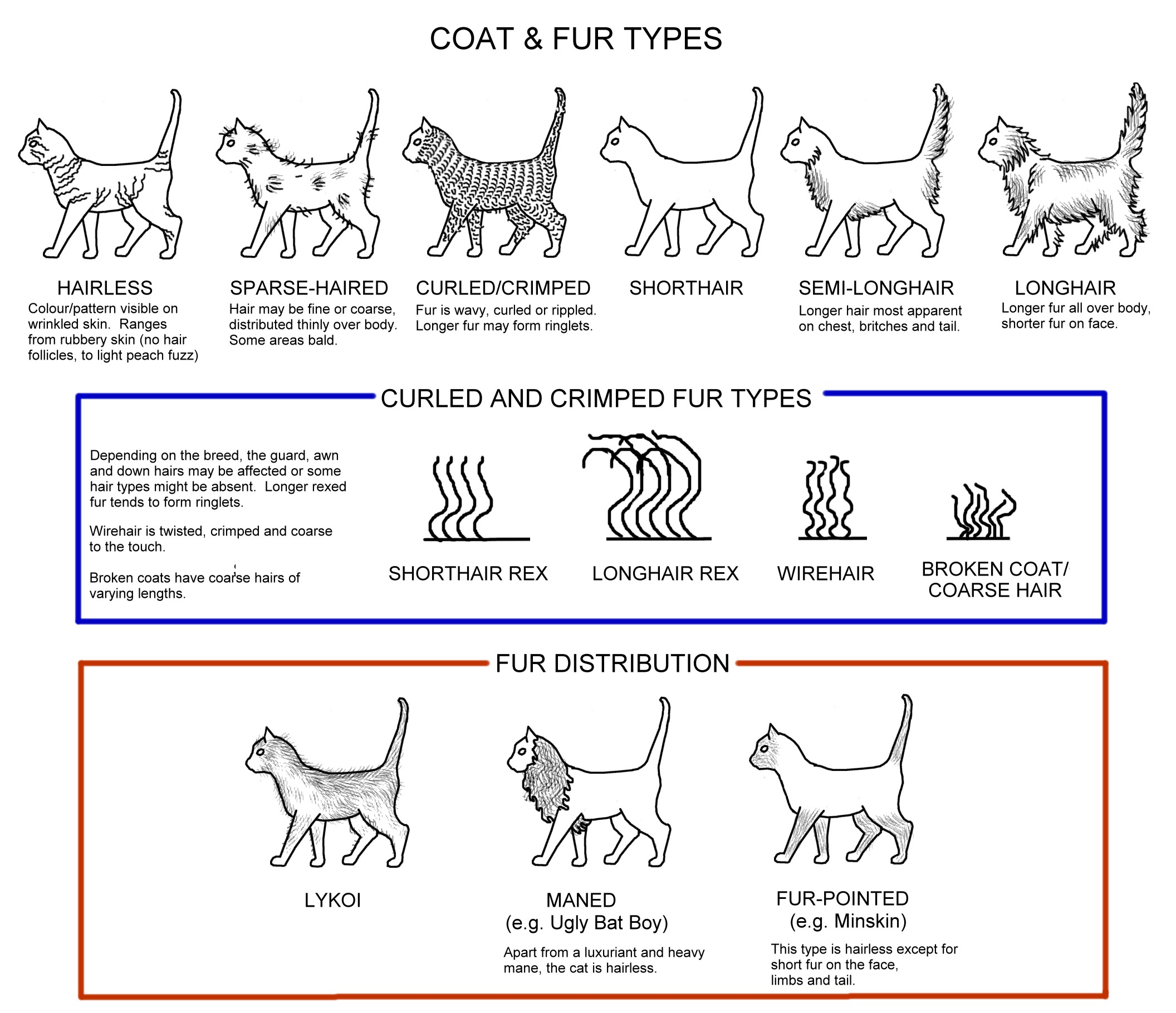
THE "YODA" MUTATION
The Yoda mutation (a colloquial term based on the resemblance to the Star Wars character) is typified by partial hairlessness on the face combined with deep skin folds (with a puffy appearance) around the eyes, The muzzle may also look puffy. The mutation hasn't been identified and theories range from a spontaneous mutation, excessive inbreeding or a mix Cornish Rex and Sphynx genes.
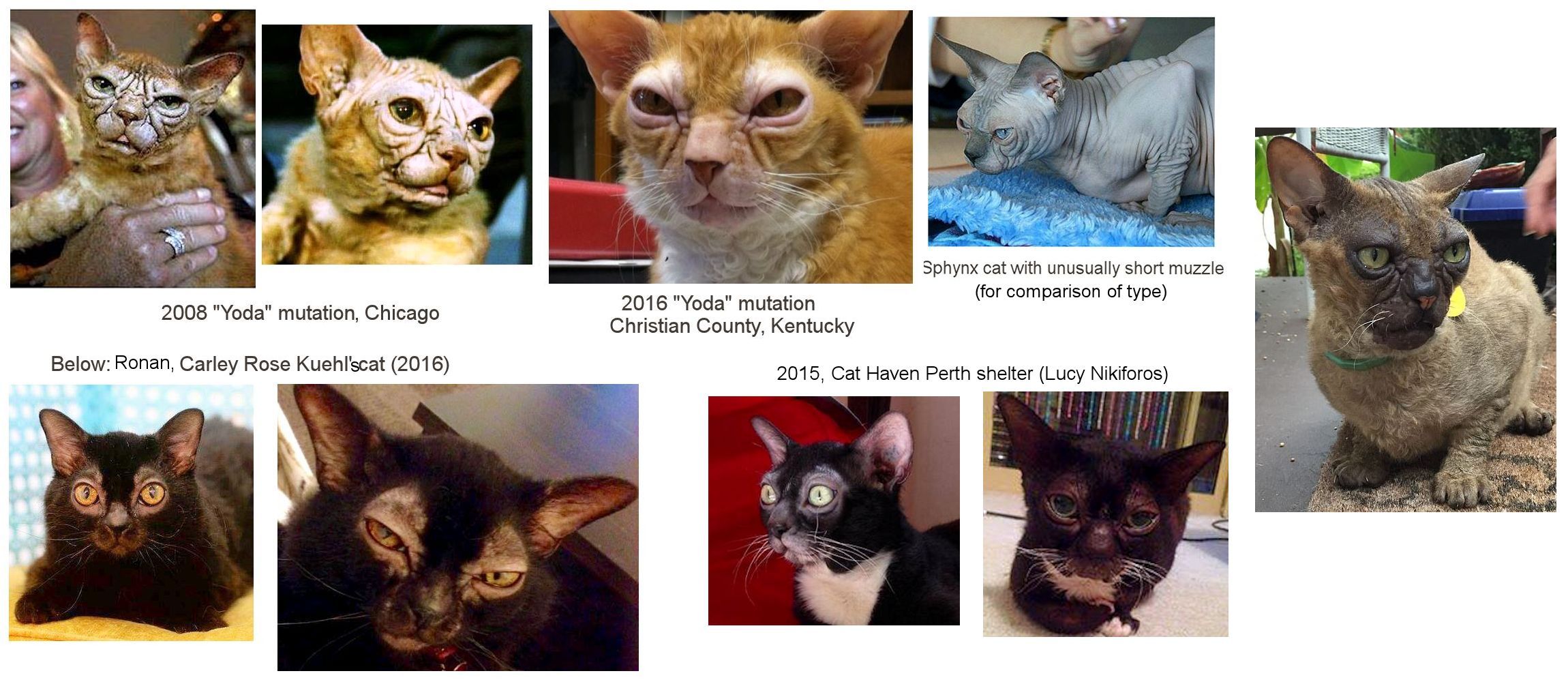
2008 Chicago Yoda, shown here with his rescuer, is said to be due to inbreeding. He appears to have thickened or puffy skin around his mouth and eyes. The ginger-and-white 2016 Kentucky Yoda with distinctive eyes was trapped at age 6 months by Christian County Animal Shelter in Kentucky and was originally thought to be due to inbreeding. He became the shelter’s mascot and, based on his features and curled fur, is now thought to be a mix of Sphynx and Cornish Rex (image 2016). The third cat, Ronan, owned by Carley Rose Kuehl, is a rescue cat from Homeward Animal Shelter, Fargo, North Dakota, He has scarring in his eyes, a heart murmur, and originally appeared to have no teeth. X-rays later showed that he does have teeth just under the gums (i.e. unerupted).
ADDITIONAL REFERENCES
Hendy-Ibbs PM: Hairless cats in Great Britain.J Hered 75:506-507,
1984.66.
Robinson R: A Third Hypotrichosis in the Domestic Cat. Genetica 55:
39-40 (1981)